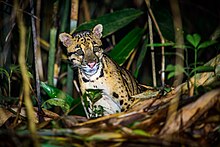| Clouded leopard | |
|---|---|

| |
| Clouded leopard in Kaeng Krachan National Park | |
| Scientific classification | |
| Domain: | Eukaryota |
| Kingdom: | Animalia |
| Phylum: | Chordata |
| Class: | Mammalia |
| Order: | Carnivora |
| Suborder: | Feliformia |
| Family: | Felidae |
| Subfamily: | Pantherinae |
| Genus: | Neofelis |
| Species: | N. nebulosa[1]
|
| Binomial name | |
| Neofelis nebulosa[1] (Griffith, 1821)
| |

| |
| Distribution of the clouded leopard[2] | |
The clouded leopard (Neofelis nebulosa), also called mainland clouded leopard, is a wild cat inhabiting dense forests from the foothills of the Himalayas through Northeast India and Bhutan to mainland Southeast Asia into South China. It was first described in 1821 on the basis of a skin of an individual from China. The clouded leopard has large dusky-grey blotches and irregular spots and stripes reminiscent of clouds. Its head-and-body length ranges from 68.6 to 108 cm (27.0 to 42.5 in) with a 61 to 91 cm (24 to 36 in) long tail. It uses its tail for balancing when moving in trees and is able to climb down vertical tree trunks head first. It rests in trees during the day and hunts by night on the forest floor.
The clouded leopard is the sister taxon to other pantherine cats, having genetically diverged 9.32 to 4.47 million years ago. Today, the clouded leopard is locally extinct in Singapore, Taiwan, and possibly also in Hainan Island and Vietnam. The wild population is believed to be in decline with fewer than 10,000 adults and no more than 1,000 in each subpopulation. It has therefore been listed as Vulnerable on the IUCN Red List since 2008. The population is threatened by large–scale deforestation and commercial poaching for the wildlife trade. Its body parts are offered for decoration and clothing, though it is legally protected in most range countries.
The clouded leopard has been kept in zoological gardens since the early 20th century. Captive breeding programs were initiated in the 1980s. In captivity, the clouded leopard has an average lifespan of 11 years.
- ^ Wozencraft, W. C. (2005). "Species Neofelis nebulosa". In Wilson, D. E.; Reeder, D. M. (eds.). Mammal Species of the World: A Taxonomic and Geographic Reference (3rd ed.). Johns Hopkins University Press. p. 545–546. ISBN 978-0-8018-8221-0. OCLC 62265494.
- ^ a b c Gray, T.; Borah, J.; Coudrat, C.N.Z.; Ghimirey, Y.; Giordano, A.; Greenspan, E.; Petersen, W.; Rostro-García, S.; Shariff, M. & Wai-Ming, W. (2021). "Neofelis nebulosa". IUCN Red List of Threatened Species. 2021: e.T14519A198843258. doi:10.2305/IUCN.UK.2021-2.RLTS.T14519A198843258.en. Retrieved 19 November 2021.
